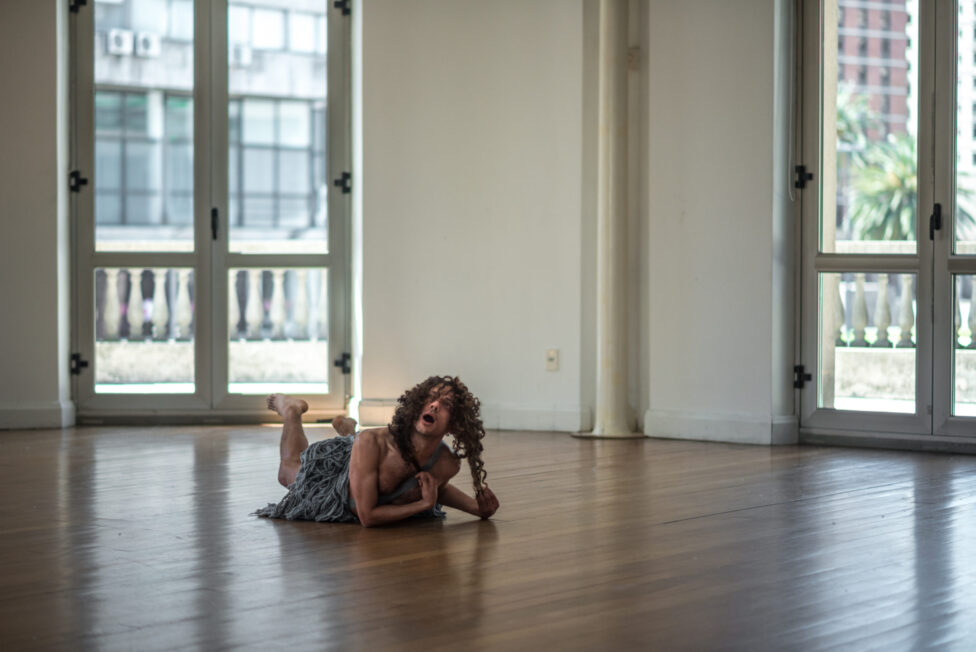What does it mean to be a choreograph(x)r?
Is it to choreograph a tridimensional image?
Is it to choreograph a dress? Is it choreographing a fabric?
How do I ask you, what does it mean to be a choreographer?
Neither female choreographer, nor male choreographer, nor they choreographer, choreograph(x) (printed in Xerox)
Many times I have asked myself who appears in that cloud of artistic, personal, spiritual, and choreographic references. Then this question amplifies those references and connections even more. Once you open up the geography in which one can circle around, the pedagogical paths one transits (be it global or glocal), it all comes together and explodes.
Then, you compose pagan dances.
Pagan dances for different perspectives, absorbed by different fields, tacky dances, bad dances.
per – for – man – sex – i want to have sex with men in per – for – man – ces
I keep thinking, I keep moving, I keep swimming, I keep changing, I keep talking.
I keep, keep .. keep…
And I keep on looking at animals, hare-cat, cat-hare, duck-goose, goose-duck, is it a duck or a goose or a turkey? Maybe I could start the piece by playing a duck-goose. What difference does it make if you see postmodern choreography on a duck-goose or a football game? What would the difference be?
But coming back to the goose, turkey, cat, hare and a motion notation system that could also include animal motion; who the hell cares if you write it?! If what feeds us in the end is … wait, what feeds us? Who feeds us?
Have you ever eaten turkey? On Thanksgiving I ate turkey, … I guess I hadn’t mentioned it before.
A lot of times artists that travel between the axis of south-north, Spanish-English, a little poor – a little rich; are looked at as animals. Compared with being savage, thought of as being exotic. Metaphors are created in the context of the zoological, allowing the ghost of colonialism to prowl freely. As a consequence you have human beings compared to animals or animals being seen in human form. In other words, internalized colonialism doesn’t have just one linguistic background, or one skin color or a particular amount of money in their pocket.
It just happens, sadly, it happens.
But, where does the relationship between man and animal come from? The animal as man, the maximum nuisance? Poor turkeys, poor geese. Why are they always at the center of the joke? When most of our movements derive from them.
At some point in my life (waiting to dance at the Escuela Nacional de Danza show, ballet division, in Montevideo in 2007) I imagined choreographing a flower waltz in a bush version. I imagined how to be a bush and come out of that bush, and what it is to be nature and return to that nature. What is dance? if dance is nature or nature is dance or if dance is really a connection? Or is it really listening to nature? How does that impact me and permeate through me? I imagined a choreo of 32 fouettes with a bleeding leg, more like a performance of Viennese actionism than a ballet, which talks about pain, a pain performance presentation (pa – pe – pre).
The choreography was about Tchaikovsky’s flower waltz, the Nutcracker one, or the “Blowjobnut”, that was a funny name given to the gay version of the Nutcracker in which I participated in the role of “Clarito” instead of “Clarita.” It was highly criticized. But there was no turning back, coming out at the age of 20 through the gay version of the Nutcracker in entertainment magazines in Montevideo had a special flavor, somewhat traumatic. But finally I did the version of the waltz of the flowers, without blood, but with glitter cheeks and in the underground theater of a shopping mall. I missed the motif crown, but I collected four thousand pesos that I invested in the Phaidon Art Encyclopedia that I still have.
From the “Blowjobnut” I turn to Louis 14, to the court of Versailles, and to the “origin” of the spectacular classical ballet. Transvestite, disrupted, all en-parruquetted, queer, trans, excessively real and fictional, propagandistic, imperial, secretive, intimate, ridiculously pictorial and curly, nostalgic for the past, with little shoes and in museums. Architectural, mathematical and sweet, musicalized and restrictive, naturalized, written and choreographed.
How far are these and other characteristics projected in stage dance currently?
The Developed World (in what could be considered as its opposite now, a vulgar world) gives us the same kind of elixir feeling, similar to an expensive drink, a luxurious, unattainable thing, like a truffle, where does hedonism stand ? I’ll make an effort to kiss the Prince of Wales’s hand. But what for? I better stop for a moment and ask myself: what for?
Dancing in universities, dancing in museums, dancing in theaters, dancing in cultural affairs offices. Maybe it is different from dancing in public squares, in the countryside, in the jungle, in waterfalls, in the background of the sea, on the rocks, on the snow, in the air, and quite different from letting the dance happen in the underworld, in andromeda, in Jupiter, in Saturn, in Uranus and inside a python.
For what and for whom do we dance?





